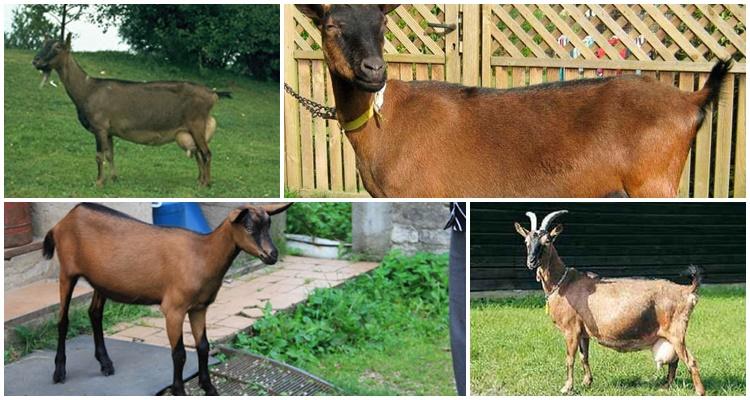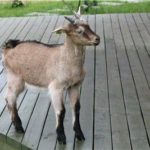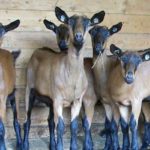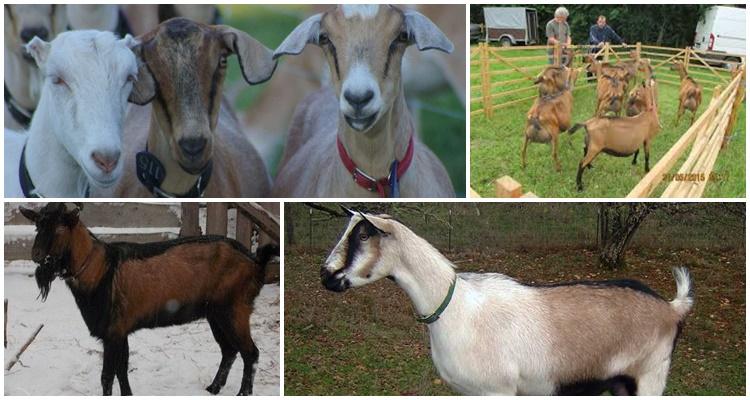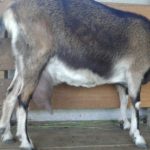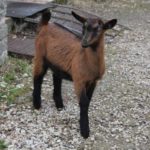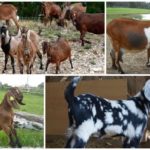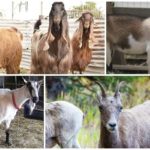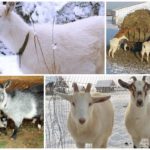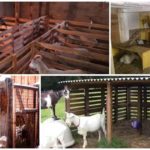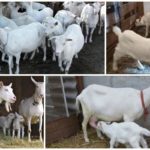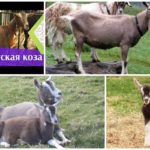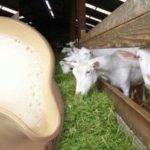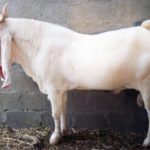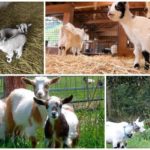The German motley noble goat is a breed that differs from the similar white “German” goat in its color. The remaining characteristics are almost identical. Based on color, size, and level of milk production, such animals are often confused with similar breeds: Alpine, Frankish, Black Forest goats and Oberhaslis. Traditionally, animals are bred for milk. In the regions where the breed originates, cheese making flourishes.
Description and characteristics of the German motley goat
This breed is distinguished by the following qualities:
- High level of productivity and milk yield.
- Suitable for manual and mechanized milking.
- Long life.
- Good health, disease resistance.
- Fertility, the ability to bear twin kids.
- Wide, voluminous udder, medium-length nipples.
- Medium or large size.
- Presence or absence of horns.
- Seasonal entry into hunting (usually from August to December inclusive).
The German Pied Goat has short, smooth hair colored in various shades of brown. It has a characteristic feature - a dark, almost black stripe along the ridge. The animals have a long, deep body, strong slender legs, a wide chest, a long neck with a small dry head, colored in a darker shade. Females weigh 55,070 kilograms, males - 70-100 kilograms.
Main pros and cons
This breed has many advantages:
- High milk production - 700-1000 kilograms of milk per lactation.
- The fat content of milk is 3.2-3.5%.
- Up to 2 kids are born per year.
- Good health.
- Good-natured and flexible character.
The disadvantages include the difficulty of purchasing purebred specimens in our country. This may be important if the farmer plans to breed animals for sale. For milk production, this may not be so important if the hybridization was carried out between two animals of dairy breeds with equally high productivity.
How to properly maintain and care for the breed
German motley goats are quite unpretentious, like other representatives of this species. But, since they are milk producers, it is extremely important to provide them with balanced natural feed and create comfortable living conditions.
When kept on pasture, the nutritional value of grass alone is not enough to maintain a stable milk supply, so it is necessary to provide additional complementary feeding. If the herd is large, then the best way to keep dairy German motley goats is to stay in a specialized room all year round.
On a farm, the building for dairy goats and kids should be clean, well lit, ventilated, and with high-quality heating.
What to feed?
For motley German goats, it is necessary to provide adequate nutrition, so their food should be balanced, consisting of several products. These are unpretentious animals that can eat straw and even an old broom, but milk from dairy females is required with indicators that meet the requirements of the industry.
Therefore, the diet includes not only fresh grass and nutritious hay, but also succulent feed, concentrates, mineral supplements, and salt. Free access to clean drinking water is required.
Breeding Features
In order to receive a fixed amount of milk, kids are weaned from the goat as early as possible, once they drink colostrum. It provides them with strong immunity and maintains lasting health. This takes from several hours to a couple of days. Then the kids are transferred to another liquid feed - a mother's milk substitute. And the goat begins to milk and give nutritious milk. A female can produce from 5 to 7 liters per day. Grown-up or dairy goats are sent for meat, except for those that are left as replacement stock.
If the farm specializes in breeding the German motley breed, and not in producing milk, the kids are kept under the goat for up to 4-5 months.
Frequent illnesses
The German motley breed of goats is subject to the same diseases that are characteristic of other animals of this species. The following diseases and health problems are more common:
- Dairy goats tend to develop inflammation of the udder (mastitis) and cracked nipples, especially in primiparous females. Such problems arise due to keeping goats in drafts, damp and dirty, cold rooms. Cracks occur due to improper milking, infection, or rough handling.
- Digestive disorders due to unbalanced or excess nutrition, as well as when eating stale or wet food.
- Inflammation of the hooves, which also occurs when kept in cold and damp mud.
- Colds. Goats are susceptible to developing a runny nose, inflammation of the respiratory tract, which can be complicated by pneumonia if the symptoms are not addressed in time.
- Animals can also suffer from parasites and skin diseases.
- Infectious diseases: brucellosis, foot and mouth disease, necrobacteriosis and so on.
Diseases can be resisted if the herd is provided with comfortable living conditions, adequate feeding, and timely veterinary care.
Where can I buy it?
Purebred animals are a rarity in homestead farming; hybrids are more common here. To breed German Spotted goats or if you want to get milk only from this breed, you should pay close attention to acquiring sires.
It is necessary to purchase purebred animals from specialized farms, which ensure not only the purity of selection, but also provide veterinary supervision over the health of the livestock. Each purchased goat or goat is supplied with passports and veterinary certificates. When purchasing, you must check the accompanying documentation and make sure that the animals are healthy and alert.
Before introducing newcomers into the herd, you need to keep them in quarantine in order to check whether they are infected with diseases in the latent phase. Only after this can the new pets be placed with the remaining goats.

